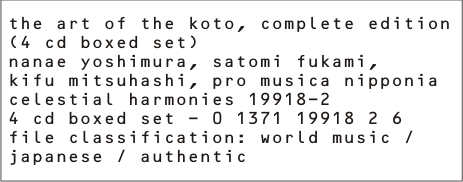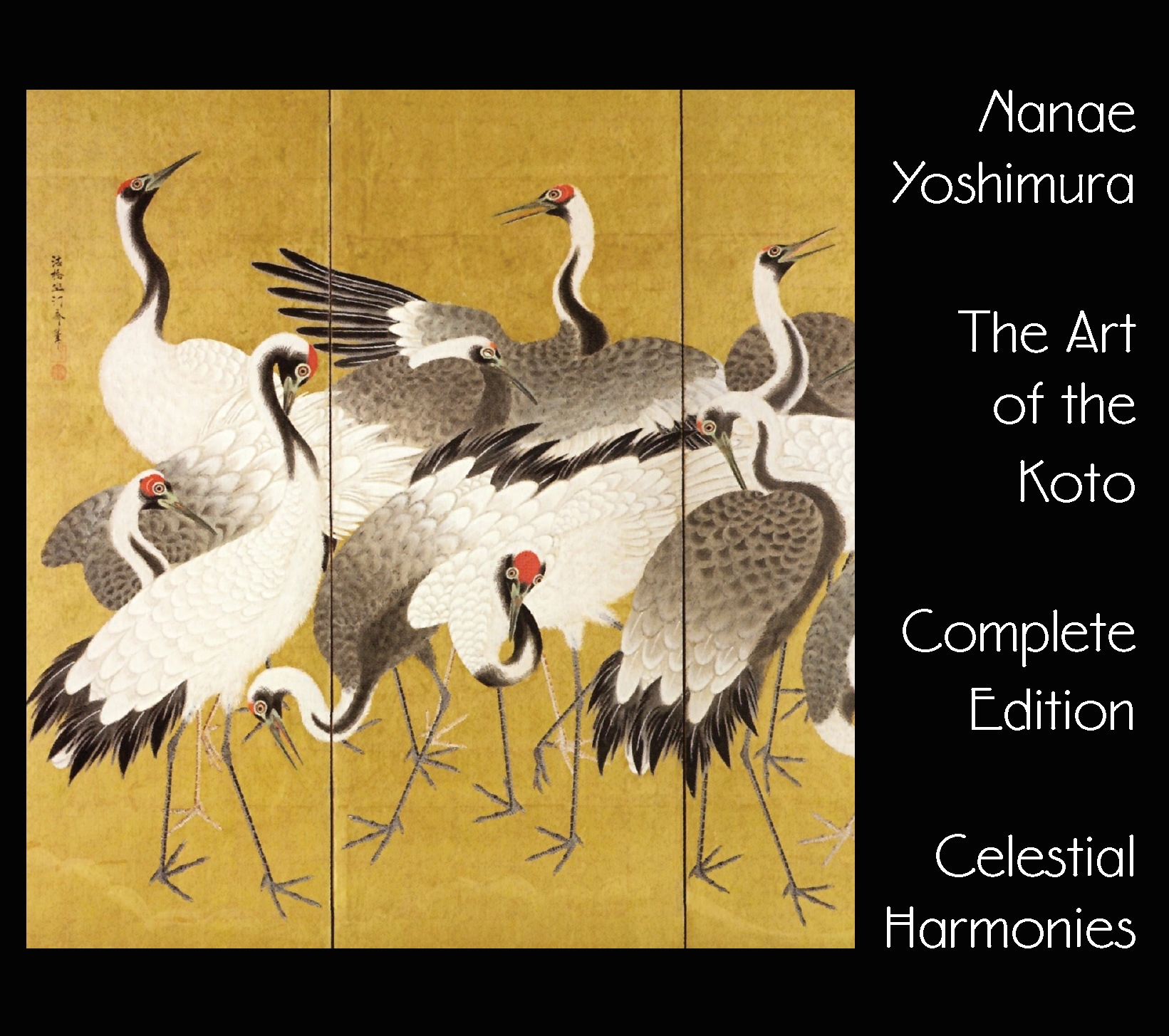(Winner
1998 of the Preis der deutschen Schallplattenkritik
[The Annual Award of the German Music Critics])http://schallplattenkritik.de/about-us
the project
The Art of the Koto, Volume One: This recording, the first
of four volumes reflecting on the history of the koto, brings
together five representative pieces from the classical repertoire
for the Japanese koto, composed between the mid–17th
and mid–19th century. This corresponds roughly to the period
of Japanese history known as the Edo, or Tokugawa period (1600-1868),
when the country was ruled by the shoguns of the Tokugawa
family from their castle in Edo, the former name of present–day
Tokyo. The strict rule of an authoritarian adminstration and a rigid
policy of national seclusion worked together to produce a relatively
long period of freedom from the disruption of internal and external
strife, during which the country changed and developed dramatically
in social, economic and cultural terms.
The music on this disc is largely a product of the daimyo,
samurai and chonin merchant–class culture of the
kamigata region of Kyoto and Osaka. This style of koto playing,
known as the Ikuta school after the great master Kengyo Ikuta (1656-1750),
also spread to and became popular in Edo and throughout the country
soon after its emergence, but the new performance style championed
by Kengyo Yamada (1757-1817) from the late years of the 18th century
in Edo became extremely popular there, overwhelming the Edo representatives
of the Ikuta school. Now the Yamada school is still largely confined
to the area around modern Tokyo whereas many Ikuta school players,
like Nanae, are also based there, and the Ikuta school dominates
the koto-music scene in most other regions of the country.
The koto belongs to the family of long zithers, and as with
many other Japanese instruments, it can be traced back to the Asian
mainland. Its history in Japan spans more than twelve centuries.
The slightly convex body of the instrument is a hollow shell made
of kiri, or paulownia wood, and its strings are traditionally made
of silk, although nylon strings are now in common use.
Booklet annotation is provided by Associate Professor Steven G.
Nelson, the only Western member of staff at the new Research Centre
for Japanese Traditional Music, Kyoto City University of Arts, Kyoto,
Japan.
The Art of the Koto, Volume Two: Volume Two of this series,
which features the artistry of the koto player Nanae Yoshimura,
comprises six pieces ranging from the core classical repertoire
of the 17th century to new works composed in the first decades of
the 20th. Two great masters stand out: Kengyo (Kengyo meaning
master) Yatsuhashi (1614-85), the founder of the tradition
of Japanese koto music played by blind musicians, and Michio
Miyagi (1894-1956), the great blind musician of the first half of
the 20th century who not only embodied that tradition but opened
up exciting new possibilities through his new compositional and
performance activities.
The koto belongs to the family of long zithers, and as with
many other Japanese instruments, it can be traced back to the Asian
mainland. Its history in Japan spans more than twelve centuries.
The slightly convex body of the instrument is a hollow shell made
of kiri, or princess tree, and its strings are traditionally
made of silk, although nylon strings are now in common use.
In the initial planning stages, it was envisaged that this second
volume should continue the chronological survey of the history of
music for koto started in Volume One, beginning with the
second half of the 19th century, where the first volume left off.
Lively discussions amongst those involved, however, encouraged Yoshimura
to include two more pieces from the core classical repertoire attributed
to Yatsuhashi: Shiki-no-kyoku as an example of his koto
kumiuta (‘song cycle’) repertoire, and Hachidan
as the third and final danmono attributed to him. The former,
especially, is a brave choice. Although it was by means of mastering
the thirty–something pieces of the kumiuta repertoire
that musicians of this genre trained until the end of the 19th century,
few koto players today are attracted by the refined restraint
that they require. In contrast, the danmono repertoire is
still extremely popular, and Yoshimura’s renditions, in this
and the preceeding volume, of all three pieces attributed to Yatsuhashi
should join the ranks of definitive readings.
Booklet annotation is provided by Associate Professor Steven G.
Nelson, the only Western member of staff at the Research Centre
for Japanese Traditional Music, Kyoto City University of Arts, Kyoto,
Japan.
The Art of the Koto, Volume Three: The third volume of The
Art of the Koto, which features the artistry of Nanae Yoshimura,
takes us into the second half of the twentieth century. It comprises
five works written between 1969 and 1989 for the nijugen,
a version of the koto with 21 rather than the traditional
thirteen strings. This instrument was developed through co-operation
between the composer Minoru Miki and the virtuoso koto
performer Keiko Nosaka in 1969.
The koto belongs to the family of long zithers, and as
with many other Japanese instruments, it can be traced back to the
Asian mainland. Its history in Japan spans more than twelve centuries.
The slightly convex body of the instrument is a hollow shell made
of kiri, or princess tree, and its strings are traditionally
made of silk, although nylon strings are now in common use.
The first three pieces are famous and well-known examples of what
may be seen as the first generation of pieces for the instrument.
The first piece, Miki’s Tennyo, gains this place
of honour by virtue of the fact that is was the first ever composed
for the instrument. The second piece, as set of five sketches named
after traditional colours, was written in 1973 by Katsutoshi Nagasawa.
Their warm and approachable melodies have contributed much to developing
a fan base for the instrument, while the comparative simplicity
of the techniques required to play them means that most nijugen
players study them as part of the learning process. Miki’s
Aki-no-kyoku (Autumn Fantasy) of 1980 was chosen for its
fresh approach toward melody for the nijugen and shakuhachi,
and its exploration of the limits of virtuosity on the former.
The two pieces that end the disc are works from the late 1980s,
commissioned for performance at her recitals. Nanae, by
Akira Nishimura, freely explores the historical roots of the flat
zither, outside the restraints of the Japanese koto tradition.
Kamu-Ogi-Guoto, by Somei Sato, travels back to the ancient
world of Japan’s mythological age, when the koto
was used as a medium of communication with the gods. It was written
with the sincere wish that the ancient gods would deign to dwell
in this modern incarnation of this instrument.
Her recent concert performance in Rome, Italy, with Kifu Mitsuhashi,
was enthusiastically compared to Tony Scott’s Music For
Zen Meditation, the seminal recording credited with starting
interest in new age music.
Booklet annotation is provided by Associate Professor Steven G.
Nelson, the only Western member of staff at the Research Centre
for Japanese Traditional Music, Kyoto City University of Arts, Kyoto,
Japan.
The Art of the Koto, Volume Four: This disk completes the
four-volume The Art of the Koto series (Celestial Harmonies
13186-2, 13187-2
and 13188-2) which features the musical
artistry of Nanae Yoshimura. As a companion especially to Vol. 3:
Works for Nijugen it contains three more compositions for the nijugen-koto,
a modern version of the koto with 20 strings (instead of the 13
strings of the traditional koto). This time, however, the focus
is on works for nijugen-koto and an ensemble of Japanese
traditional instruments, played by members of Pro Musica Nipponia
(Nihon Ongaku Shudan).
On this disk two compositions by Minoru Miki can be heard: Tatsuta-no-kyoku
written in 1971 is one of his earliest solo compositions for the
new instrument nijugen-koto which was 'invented' in 1969
(Track 7). The other is his Concerto Requiem for nijugen-koto
solo and an ensemble of Japanese instruments (Track 1), one of Miki's
most important works written in 1981. Tracks 2-6 include a piece
in five movements by the versatile composer Takashi Yoshimatsu (*1953).
Originally written in 1998 for nijugen-koto solo and a trio
of European instruments, it was newly
arranged in 1999 for an ensemble of Japanese instruments to be performed
during 'Pro Musica Nipponia the 156th regular concert' on 8th August
2000 in Tokyo.
the artists
Nanae Yoshimura was born in Tokyo and began to study the koto
from the age of three, receiving her teaching license with the Matsu-no-mi
Kai of Ikuta–school koto performance at the age of sixteen.
She studied the classical repertoire for koto and jiuta
shamisen with Soju Nosaka of the Kyushu lineage, and contemporary
works for koto and nijugen (21-stringed koto)
with Nosaka's daughter, Keiko Nosaka. She has been especially active
as a specialist on the latter instrument since the early 1970s,
always in search of new possibilities for musical expression and
extending the horizons of the instrument.
Born in Tokyo in 1950, Kifu Mitsuhashi studied Kinko-school shakuhachi
with Sofu Sasaki and the classical honkyoku repertoire
of the Fuke school with Chikugai Okamoto. He is the recipient of
numerous awards in Japan, holds the qualification of shihan (master)
in the Kinko school, and runs his own group for shakuhachi performance,
the Kifu Kai. He has recorded the 3-CD series The Art of
the Shakuhachi Celestial Harmonies.
Pro Musica Nipponia was founded in 1964 by composer Minoru Miki
(*1930) with the intention of devising a vital form of musical expression
based on ancient forms and instruments linked to the spirit of the
present. The ensemble, with its highly professional and talented
members, has premiered dozens of works by both Japanese and foreign
composers and has built up an impressive repertoire of new pieces.
Some of them have been written by Miki himself, thus demonstrating
the potential of traditional Japanese instruments for creating a
modern and international music. Yoshimura became a member of Pro
Musica Nipponia in 1972 and continues to perform with the ensemble
as a soloist until today.
tracklist







